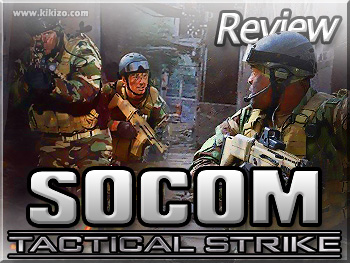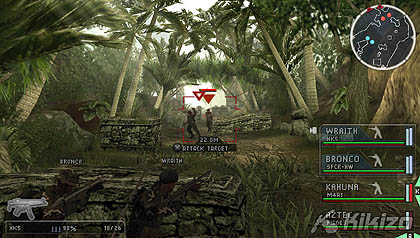SOCOM: U.S. Navy SEALs Tactical Strike
It's another decent new SOCOM for the PSP.
| Version PSP | Developer Slant Six Games | Publisher Sony | Genre Strategy |
||||
They say you can't judge a book by its cover and never has this been truer than in the case of SOCOM: Tactical Strike. Whilst to the untrained eye it might look like your regular over-the-shoulder shooter, nothing could be further from the truth. Taking its moniker from the United States Special Operations Command, the PSP version of the popular franchise is more of a tactical third-person shooter combined with some real-time strategy elements. In fact, the general pace of SOCOM is so much slower than your typical action-espionage game that it could almost conceivable be implemented in a turn-based fashion. Metal Gear Ac!d anyone?

Unlike its older SOCOM siblings, Tactical Strike evolves outside of the US Navy Seals and - perhaps making judicious use of SOCOMs real world tenet in overseeing command of the various branches of the US military - allows you to play as soldiers from regiments as diverse as Germany's Kommando Spezialkrafte, South Korea's 707th Special Missions Battalion and of course the UK's very own Special Air Services (the SAS). Set against the backdrop of a troubled Panama City, your first mission involves rescuing one of your ambassadors and a Panamanian Interior Minister whom have been kidnapped by local insurgents. Unfortunately there is no sign of him, with you instead finding a wounded Panamanian Security Forces agent who assists you in further tracking down the ambassador.
With a four man team to command, it is perhaps not entirely unexpected to find that you don't have direct control over your squad. Instead you give them instructions to follow which they do to the best of their ability. This might be to simply go from A to B, to breach a doorway with stealth or all guns blazing, or to provide covering fire for other members of your team. Although essentially a four man unit, your squad can easily be split up into smaller groups - either the 2 man Alpha and Bravo units or individual men if so desired. The former is achieved by a tap of the right shoulder button whilst the later is achieved by depressing the left shoulder button and then using the d-pad to select the required soldier. Depressing the right shoulder button again will regroup your men into a single unit.
Giving instructions to your men as opposed to taking direct control of them is a brave decision - one that lives or dies on effective and responsive AI. It is often necessary and useful to split your men up so that they can flank groups of enemy soldiers, provide sniper fire cover or simply because it is easier to move two men undetected than four. However, the AI doesn't quite live up to expectations. It is not totally devoid of intelligence but giving anything more than simple instructions from your men is problematic should any unexpected situations arise.
For instance, should your men run into enemy soldiers between their current position and a waypoint some distance away, then the results are mostly unpredictable and often unwanted, with them regularly continuing on their path until right on top of the enemy or even until they are fired upon. Enemy soldiers also suffer from AI glitches too, with you being able to use a sniper to take out an enemy soldier without his nearby comrades even noticing.
Worst of all though is the pathfinding which - should you split your group up and spread your units out over a distance - then regrouping them and moving to a new location will often find some of them stuck in the scenery and unable to progress, forcing you to switch to the offending units and babysit them all the way back. In practice this all means that you can only give simple and short instructions, such as moving from one cover point to the next.
As stated, selecting your men is a simple affair, with a nice glow surrounding those whom are currently under your command and with the camera view switching to the correct unit. There are still some further annoying hiccups however. The circle button brings up the movement reticule which you use to indicate where you men should move to.
This is restricted though by both the environment and by a truly awful camera. Should you want to position your men on the other side of even a simple obstruction - such as a log or a rock - then you have to move the marker all the way around said obstruction instead of simply through it as you can only position the marker where your men can actually walk. Should you find yourself surprised by enemy fire then this delay can prove the difference between life and death. Not only this though but the loops, spins and whirls provided by the disjarring camera are more suited to a roller-coaster ride than the battlefield. You can also only see from your men's point of view, so trying to navigate around corners can feel like the blind leading the blind.
If your men should become seriously wounded, then they will cry out for help as they lay injured. They can be revived should you get to them in time and apply first-aid which takes a short amount of time. Thus you must take out any remaining hostiles as soon as possible so that you can rescue your downed soldiers. A similar situation occurs when performing other operations, such as hacking computers and unlocking doors - either all the hostiles in the area must be neutralised, or some combination of stealth and covering fire must also be employed.
Despite these AI and camera problems, it is not all bad news. There is plenty of atmosphere provided by the constant radio chatter and the game contains some great audio and visuals. There are also plenty of weapons to choose from, although determining which ones are more suited for a particular mission is presumably only for gun-buffs as no stats are provided. The range of missions is also wide and varied with each one allowing you to complete it however you see fit and whichever way suits your own playing style. In the end though, these positives only provide a temporary patch over the game's problems and sooner or later you'll see its tears. In the end it all comes down to how long you can put up with them.
| ||||||||||||
|





















 Satoru Iwata Video Interview - the late Nintendo president spoke with Kikizo in 2004 as 'Nintendo Revolution' loomed.
Satoru Iwata Video Interview - the late Nintendo president spoke with Kikizo in 2004 as 'Nintendo Revolution' loomed. Kaz Hirai Video Interview - the first of Kikizo's interviews with the man who went on to become global head of Sony.
Kaz Hirai Video Interview - the first of Kikizo's interviews with the man who went on to become global head of Sony. Ed Fries Video Interview - one of Xbox's founders discusses an epic journey from Excel to Xbox.
Ed Fries Video Interview - one of Xbox's founders discusses an epic journey from Excel to Xbox. Yu Suzuki, the Kikizo Interview - we spend time with one of gaming's most revered creators.
Yu Suzuki, the Kikizo Interview - we spend time with one of gaming's most revered creators. Tetris - The Making of an Icon: Alexey Pajitnov and Henk Rogers reveal the fascinating story behind Tetris
Tetris - The Making of an Icon: Alexey Pajitnov and Henk Rogers reveal the fascinating story behind Tetris Rare founders, Chris and Tim Stamper - their only interview? Genuinely 'rare' sit down with founders of the legendary studio.
Rare founders, Chris and Tim Stamper - their only interview? Genuinely 'rare' sit down with founders of the legendary studio. The History of First-Person Shooters - a retrospective, from Maze War to Modern Warfare
The History of First-Person Shooters - a retrospective, from Maze War to Modern Warfare